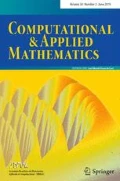Abstract
T-spline has been recently developed to represent objects of arbitrary shapes in computer-aided design, computer graphics, and reverse engineering. In fact, fitting a T-spline over a point cloud is usually ineffective by using traditional iterative fit-and-refine paradigm. In traditional T-spline least-square fitting method, all control points are recomputed in each iteration, which costs large amount of calculations. In this paper, we propose a fast T-spline fitting method based on T-mesh segmentation. The segmentation technology is introduced to identify the inactive and active region of T-mesh. Computational costs can be largely reduced since only the control points in the active part need to be recalculated in the upcoming process, while those in inactive part are kept invariant once the fitting accuracy is achieved. Classical datasets are used to validate the proposed fast fitting method, and the experimental results yield that a total running time is reduced to \(34\%\) of the traditional T-spline fitting method. We argue this method is particularly useful in the reconstruction of scanned scatter data of which the parameter distribution is not uniform.























Similar content being viewed by others
References
Bazilevs Y, Calo VM, Cottrell JA, Evans JA, Hughes TJR, Lipton S, Scott MA, Sederberg TW (2015) Isogeometric analysis using t-splines. Comput Methods Appl Mech Eng 199(5):229–263
Campen M, Zorin D (2017) Similarity maps and field-guided t-splines: a perfect couple. ACM Trans Graph 36(4):1–16
Feng TY, Taguchi Y (2017) Fastfit: a fast t-spline fitting algorithm. Comput Aided Des 92:11–21
Floater MS (2003) Mean value coordinates. Comput Aided Geom Des 20(1):19–27
Floater MS, Kai H (2005) Surface parameterization: a tutorial and survey. Adv Multiresolution Geom Model 1:157–186
Forsey DR, Bartels RH (1988) Hierarchical b-spline refinement. ACM Siggraph Comput Graph 22(4):205–212
Gan WF, Fu JZ, Shen HY, Chen ZY, Lin ZW (2014) Five-axis tool path generation in CNC machining of t-spline surfaces. Comput Aided Des
Hughes TJR, Cottrell JA, Bazilevs Y (2005) Isogeometric analysis: CAD, finite elements, nurbs, exact geometry and mesh refinement. Comput Methods Appl Mech Eng 194(39):4135–4195
Kovacs D, Bisceglio J, Zorin D (2015) Dyadic t-mesh subdivision. ACM Trans Graph 34(4):143:1–143:12
Lin H (2012) Adaptive data fitting by the progressive-iterative approximation. Comput Aided Geom Des 29(7):463–473
Lin H, Zhang Z (2013) An efficient method for fitting large data sets using t-splines. SIAM J Sci Comput 35(6):A3052–A3068
Morgenstern P, Peterseim D (2015) Analysis-suitable adaptive t-mesh refinement with linear complexity. Comput Aided Geom Des 34:50–66
Piegl L, Tiller W (1997) The NURBS Book. Springer, Berlin
Scott MA, Li X, Sederberg TW, Hughes TJR (2012) Local refinement of analysis-suitable t-splines. Comput Methods Appl Mech Eng 213–216(1):206–222
Sederberg TW, Zheng J, Bakenov A, Nasri A (2003) T-splines and t-nurccs. ACM Trans Graph 22(3):477–484
Sederberg TW, Cardon DL, Finnigan GT, North NS, Zheng J, Lyche T (2004) T-spline simplification and local refinement. ACM Trans Graph 23(3):276
Sheffer A, Praun E, Rose K (2006) Mesh parameterization methods and their applications. Found Trends Comput Graph Vis 2(2):105–171
Speleers H, Manni C (2016) Effortless quasi-interpolation in hierarchical spaces. Numer Math 132(1):155–184
Wang Y, Zheng J (2007) Adaptive t-spline surface approximation of triangular meshes. In: International conference on information
Wang Y, Zheng J (2013) Curvature-guided adaptive t-spline surface fitting. Comput Aided Des 45:1095–1107
Wang A, Zhao G, Li YD (2014) An influence-knot set based new local refinement algorithm for t-spline surfaces. Expert Syst Appl 41(8):3915–3921
Weiyin MA, Peiren HE (1998) B-spline surface local updating with unorganized points. Comput Aided Des 30(11):853–862
Xiao W, Liu Y, Rui L, Wei W, Zheng J, Gang Z (2016) Reconsideration of t-spline data models and their exchanges using step. Comput Aided Des 79(C):36–47
Xin L, Zheng J, Sederberg TW, Hughes TJR, Scott MA (2015) On linear independence of t-spline blending functions. Comput Aided Geom Des 29(1):63–76
Ying H, Wang K, Wang H, Gu X, Hong Q (2006) Manifold t-spline. In: International conference on geometric modeling and processing
Zheng J, Wang Y, Seah HS (2005) Adaptive t-spline surface fitting to z-map models. In: International conference on computer graphics and interactive techniques in Australasia and South East Asia
Author information
Authors and Affiliations
Corresponding authors
Additional information
Communicated by Jose Alberto Cuminato.
Publisher's Note
Springer Nature remains neutral with regard to jurisdictional claims in published maps and institutional affiliations.
This work is supported by National Key Research and Development Program of China (Grant No. 2018YFB1107402), Beijing Natural Science Foundation (Z180005) and NSFC (Grant No. 11290141).
Rights and permissions
About this article
Cite this article
Lu, Z., Jiang, X., Huo, G. et al. A fast T-spline fitting method based on efficient region segmentation. Comp. Appl. Math. 39, 55 (2020). https://doi.org/10.1007/s40314-020-1071-6
Received:
Revised:
Accepted:
Published:
DOI: https://doi.org/10.1007/s40314-020-1071-6




